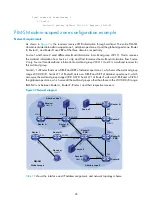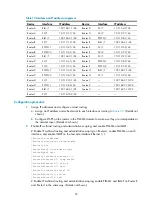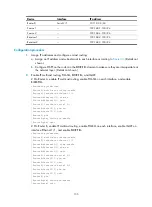
91
Verifying the configuration
Use the
display pim interface
command to display PIM information on each interface. For example:
# Display PIM information on Router D.
[RouterD] display pim interface
VPN-Instance: public net
Interface NbrCnt HelloInt DR-Pri DR-Address
Eth1/1 0 30 1 10.110.5.1 (local)
Ser2/0 1 30 1 192.168.1.2 (local)
Pos5/0 1 30 1 192.168.2.2 (local)
Pos5/1 1 30 1 192.168.3.2 (local)
Use the
display pim neighbor
command to display PIM neighboring relationship among the routers. For
example:
# Display PIM neighboring relationship on Router D.
[RouterD] display pim neighbor
VPN-Instance: public net
Total Number of Neighbors = 3
Neighbor Interface Uptime Expires Dr-Priority
192.168.1.1 Ser2/0 00:02:22 00:01:27 1
192.168.2.1 Pos5/0 00:00:22 00:01:29 3
192.168.3.1 Pos5/1 00:00:23 00:01:31 5
Assume that Host A needs to receive the information addressed to multicast group G 225.1.1.1. After the
multicast source S 10.110.5.100/24 sends multicast packets to the multicast group G, an SPT is
established through traffic flooding. Routers on the SPT path (Router A and Router D) have their (S, G)
entries. Host A sends an IGMP report to Router A to join the multicast group G, and a (*, G) entry is
generated on Router A. You can use the
display pim routing-table
command to display PIM routing table
information on each router. For example:
# Display PIM routing table information on Router A.
[RouterA] display pim routing-table
VPN-Instance: public net
Total 1 (*, G) entry; 1 (S, G) entry
(*, 225.1.1.1)
Protocol: pim-dm, Flag: WC
UpTime: 00:04:25
Upstream interface: NULL
Upstream neighbor: NULL
RPF prime neighbor: NULL
Downstream interface(s) information:
Total number of downstreams: 1
1: Ethernet1/1
Protocol: igmp, UpTime: 00:04:25, Expires: never
(10.110.5.100, 225.1.1.1)
Protocol: pim-dm, Flag: ACT
UpTime: 00:06:14
















































